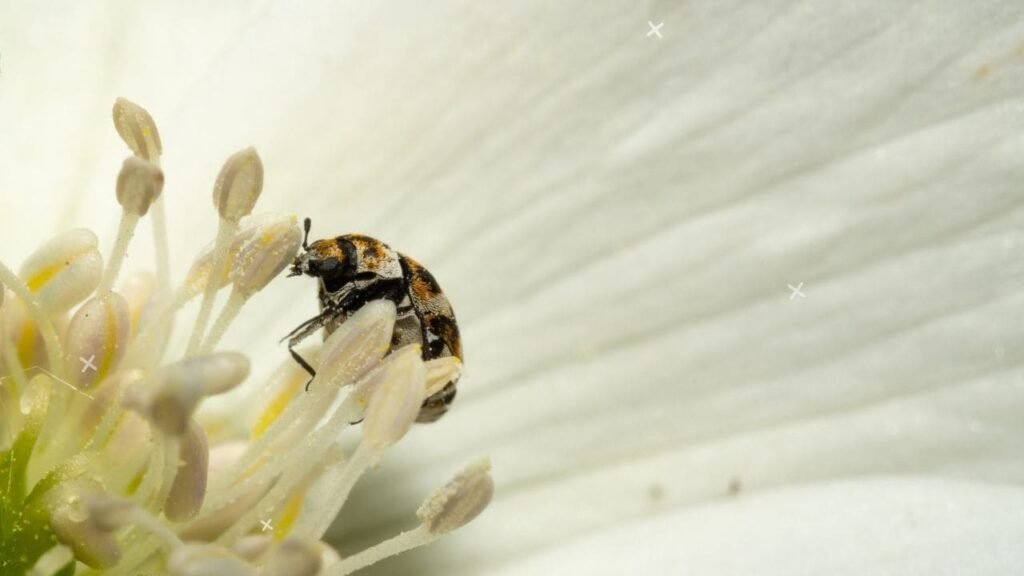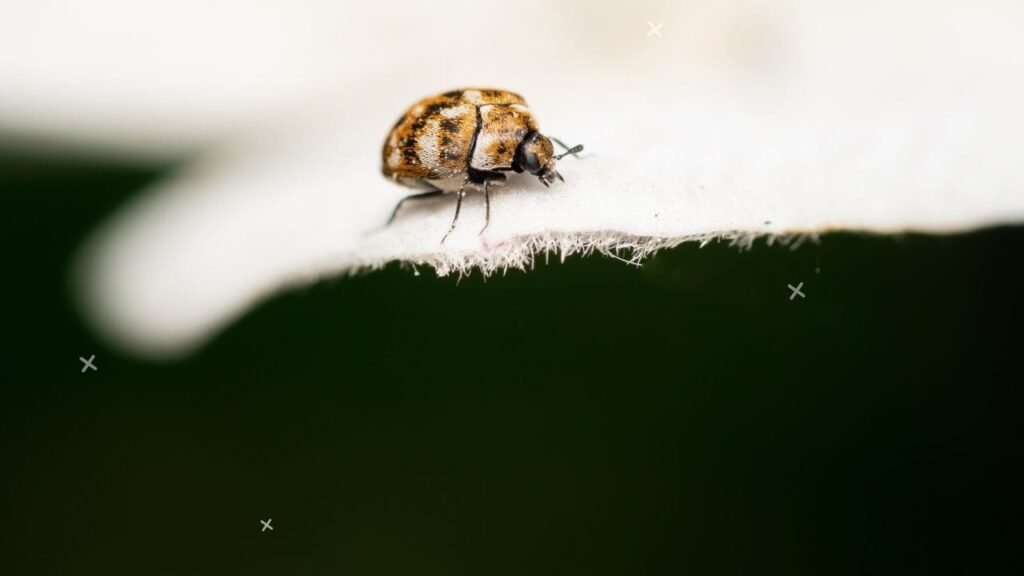


From time to time I find myself daydreaming about what life would be like if little things didn’t bug me so much. And I mean that quite literally when it comes to those pesky carpet beetles! As small as they are, carpet beetles can cause big damage if an insect infestation gets out of control.
I’m guessing if you’re reading this blog on carpet beetle prevention, you may have had experience with these fabric feeding fiends. Let’s address the key question – do carpet beetles travel with you? Learn everything you need to know about stopping them from hitching rides.
Before we dive into preventing carpet beetles from traveling along, let’s start with the basics. Carpet beetles are tiny beetles that feast on natural textiles and materials at home. At just 2-5mm in size, they seem harmless. But don’t be fooled! Given the opening, carpet beetles will happily chew through wool, silk, leather, fur, carpets, furniture stuffing, pantry items and more.
These household pests tend to live a few months. In their short lifetime, a female beetle can deposit dozens of eggs that morph into ravenous carpet beetle larvae. It’s the worm-like larvae that inflict damage by eating and eventually pupating within materials. Talk about eating you out of house and home!
Now, onto the main question – Do Carpet Beetles Travel With You?

The short answer is yes – adult carpet beetles and larvae are very capable of tagging along for rides with humans and multiplying in new sites. Adult beetles hide out and hibernate in dark, undisturbed crevices inside our garments, bags, cars, moving vans and more. Simultaneously, larvae may actively nibble unseen on textiles or organic debris.
Before going anywhere, I strongly advise enacting protective actions around your residence. This prevents carpet beetles from latching onto you initially.
By upholding sanitation and scanning for carpet beetle issues, you minimize chances for them to later spread through clothing contamination or travel bag infestation. An ounce of prevention is truly worth a pound of cure!

Ah, moving and traveling – my favorite adventures! But I’ve learned the hard way carpet beetles like to tag along if you don’t take safety measures. Here are my top tips to keep them out of luggage, moving boxes, and new places:
Bottom line, carpet beetles ride with us because we accidentally transport them. They exploit fabrics and organic things we shuttle around to breed, eat, and continually spread!
While the odd hitchhiker may be inevitable, the tips above truly assist in breaking their life cycles. Concentrating on prevention at home and especially pre-travel limits opportunities for undetected egg-laying.
Washing and sequestering fabrics denies larvae nourishment. Vacuuming up eggs and larvae eliminates them. Inspecting goods thwarts beetles from reaching new unaffected areas. It’s not astrophysics, just steadfast monitoring and hygiene whenever you’re moving around.
At day’s end, carpet beetles travel alongside humans since we actually enable their movement! But not to worry, upholding prevention gives you the upper hand to revoke their rideshare access.
By focusing on meticulous cleaning, isolation protocols, and inspections when shifting items in/out of a home, you mitigate constant reintroduction risks. Ongoing prevention halts carpet beetle infestations from taking permanent footholds. No more freeloading fabric fiends destroying your wardrobe!
Alright my friends, that about covers my best tips on barring carpet beetles from your luggage. Let me know in the comments if you have additional questions! Whether you’re battling an existing issue or striving to prevent one, I’m glad to provide more insights. Now, excuse me – I have some suitcases to sanitize before my upcoming trip…
What are the most effective methods for killing carpet beetle eggs, larvae, and adults during travel clothing treatment?
The best way to kill all life stages of carpet beetles on clothing and textiles before traveling is to use heat or cold treatment. Washing in very hot 130°F (54°C) water can exterminate eggs and larvae, while freezing small items for at least 4 days at 0°F (-18°C) can kill all life stages by rupturing cell membranes.
For delicate items, specialized heating chambers or fumigation may be required. Additionally, thorough vacuuming with a brush attachment picks up eggs and larvae. Insecticide sprays specifically labeled for fabric pests could also be used. Combining methods ensures you eliminate any sneak hitchhikers.
If I discovered carpet beetles while packing my moving truck, what emergency steps should I take to avoid bringing an infestation to my new home?
Finding live carpet beetles while packing calls for emergency quarantine protocols. First, unpack the insect-contaminated boxes and thoroughly inspect all items. Shake out clothing vigorously outside. Vacuum furniture crevices and the moving truck interior to capture eggs and larvae. Set aside infested-looking textiles and use Garment bags temporarily. When secured in the new home, launder clothing/linens immediately per hot water protocols.
Use freezer or heating treatment for wardrobe items that require special care. Maintain diligent monitoring for additional sightings. Put pheromone traps in closets to capture adults. Staying vigilant with thorough cleaning and containment limits the beetles spread through a moved household. Implement prevention going forward.
What household areas should I regularly inspect if attempting to prevent carpet beetles from traveling with me to vacation rentals or hotels when I travel?
The top household areas to monitor regularly for signs of carpet beetle infestation when aiming to prevent them from tagging along during travels include: inside wardrobes, dressers and clothing storage areas – shake out garments and check corners; under furniture and along edges of carpet, rugs, beds – scan for larvae and skins; in pet bedding and pet hair covered areas; inside pantry goods containers and the kitchen pantry itself for spilled grains/flours; behind artwork or wall hangings that contain organic materials; along baseboards and windowsills where dead insects accumulate.
Check luggage interiors pre-travel. Finding signs promptly makes containment and extermination easier. Prevention starts at home so there’s no contamination risk when staying in hotels or vacation rentals.
How might I safely rid my luggage of carpet beetle eggs, larvae or adults if it’s contaminated right before airline travel and I have no access to hot water or freezer treatment?
If discovering luggage contamination right before traveling without access to sanitation methods, try these steps: First, thoroughly vacuum the luggage interior and exterior with a brush attachment. Next, use sticky packing tape rolled over the bag to pickup and contain stray eggs, larvae or adults.
Spray rubber cement along edges and crevices as a barrier trap – it’s sticky like tape and dries hard. If any clothing items seem questionable, shake them outside and contain in plastic bags tied shut until reaching destination. There seal tightly in the hotel room and launder or treat immediately. For solid removal, rub a thin coating of diatomaceous earth into the luggage itself – the fine powder desiccates small insects. Maintaining vigilance at destination prevents spread while enabling access to robust treatment methods for a full extermination.
What preventative measures should be taken when moving into a new home to ensure no trailing carpet beetles transferred “as is” with second-hand vintage furniture I purchased?
When moving second-hand or vintage furniture to a new residence, proactive measures should include: Inspecting items closely first for existing damage holes, spots, or signs of infestation. Next, clean by vacuuming all crevices, edges where organic debris may hide eggs/larvae. Steam clean upholstered furniture on the hottest setting. Dust baseboards and wood pieces with diatomaceous earth for desiccation effects.
Wrap or cover items with plastic for moving day to contain them just in case. Unpack furniture and thoroughly vacuum new home’s floors/baseboards before placing items. Maintain space between walls when situating vintage pieces to enable ongoing monitoring for issues. Check routinely underneath for signs of beetle larvae falling from feeding sites unseen inside. Capture stray adults with pheromone traps. Catching and containing an infestation promptly is key to prevention!